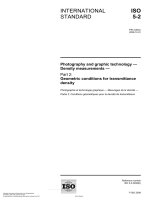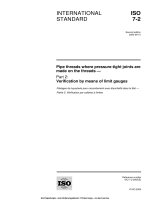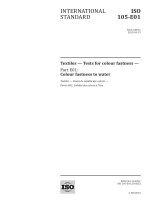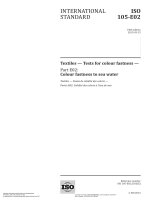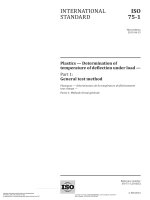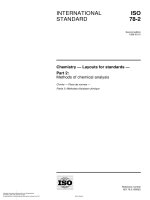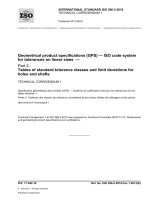Tiêu chuẩn iso 00075 2 2013
Bạn đang xem bản rút gọn của tài liệu. Xem và tải ngay bản đầy đủ của tài liệu tại đây (293.03 KB, 16 trang )
INTERNATIONAL
STANDARD
ISO
75-2
Third edition
2013-04-15
Plastics — Determination of
temperature of deflection under load —
Part 2:
Plastics and ebonite
Plastiques — Détermination de la température de fléchissement
sous charge —
--``,`,,,,,,`,,,`,``,,`,,```,`,`-`-`,,`,,`,`,,`---
Partie 2: Plastiques et ébonite
Reference number
ISO 75-2:2013(E)
Copyright International Organization for Standardization
Provided by IHS under license with ISO
No reproduction or networking permitted without license from IHS
Licensee=University of Alberta/5966844001, User=sharabiani, shahramfs
Not for Resale, 11/30/2013 22:05:39 MST
© ISO 2013
ISO 75-2:2013(E)
COPYRIGHT PROTECTED DOCUMENT
© ISO 2013
All rights reserved. Unless otherwise specified, no part of this publication may be reproduced or utilized otherwise in any form
or by any means, electronic or mechanical, including photocopying, or posting on the internet or an intranet, without prior
written permission. Permission can be requested from either ISO at the address below or ISO’s member body in the country of
the requester.
ISO copyright office
Case postale 56 • CH-1211 Geneva 20
Tel. + 41 22 749 01 11
Fax + 41 22 749 09 47
Web www.iso.org
Published in Switzerland
ii
Copyright International Organization for Standardization
Provided by IHS under license with ISO
No reproduction or networking permitted without license from IHS
--``,`,,,,,,`,,,`,``,,`,,```,`,`-`-`,,`,,`,`,,`---
© ISO 2013 – All rights reserved
Licensee=University of Alberta/5966844001, User=sharabiani, shahramfs
Not for Resale, 11/30/2013 22:05:39 MST
ISO 75-2:2013(E)
Contents
Page
Foreword ........................................................................................................................................................................................................................................ iv
Introduction..................................................................................................................................................................................................................................v
2
3
4
5
6
7
8
9
10
11
Scope ................................................................................................................................................................................................................................. 1
Normative references ...................................................................................................................................................................................... 1
Terms and definitions ..................................................................................................................................................................................... 2
Principle ........................................................................................................................................................................................................................ 2
Apparatus..................................................................................................................................................................................................................... 2
5.1
Means of producing a flexural stress ................................................................................................................................... 2
5.2
Heating equipment .............................................................................................................................................................................. 2
5.3
Weights .......................................................................................................................................................................................................... 2
5.4
Temperature-measuring instrument ................................................................................................................................... 2
5.5
Deflection-measuring instrument .......................................................................................................................................... 2
Test specimens........................................................................................................................................................................................................ 2
6.1
General ........................................................................................................................................................................................................... 2
6.2
Shape and dimensions...................................................................................................................................................................... 2
6.3
Specimen inspection .......................................................................................................................................................................... 3
6.4
Number of test specimens............................................................................................................................................................. 3
6.5
Test-specimen preparation .......................................................................................................................................................... 3
6.6
Annealing ..................................................................................................................................................................................................... 3
Conditioning.............................................................................................................................................................................................................. 3
Procedure..................................................................................................................................................................................................................... 3
8.1
Calculation of force to be applied............................................................................................................................................ 3
8.2
Initial temperature of the heating equipment ............................................................................................................. 3
8.3
Measurement............................................................................................................................................................................................ 3
Expression of results ........................................................................................................................................................................................ 4
Precision ....................................................................................................................................................................................................................... 4
Test report ................................................................................................................................................................................................................... 4
Annex A (informative) Precision............................................................................................................................................................................... 5
Bibliography ................................................................................................................................................................................................................................ 9
© ISO 2013 – All rights reserved
Copyright International Organization for Standardization
Provided by IHS under license with ISO
No reproduction or networking permitted without license from IHS
Licensee=University of Alberta/5966844001, User=sharabiani, shahramfs
Not for Resale, 11/30/2013 22:05:39 MST
iii
--``,`,,,,,,`,,,`,``,,`,,```,`,`-`-`,,`,,`,`,,`---
1
ISO 75-2:2013(E)
Foreword
ISO (the International Organization for Standardization) is a worldwide federation of national standards
bodies (ISO member bodies). The work of preparing International Standards is normally carried out
through ISO technical committees. Each member body interested in a subject for which a technical
committee has been established has the right to be represented on that committee. International
organizations, governmental and non-governmental, in liaison with ISO, also take part in the work.
ISO collaborates closely with the International Electrotechnical Commission (IEC) on all matters of
electrotechnical standardization.
International Standards are drafted in accordance with the rules given in the ISO/IEC Directives, Part 2.
The main task of technical committees is to prepare International Standards. Draft International
Standards adopted by the technical committees are circulated to the member bodies for voting.
Publication as an International Standard requires approval by at least 75 % of the member bodies
casting a vote.
Attention is drawn to the possibility that some of the elements of this document may be the subject of
patent rights. ISO shall not be held responsible for identifying any or all such patent rights.
ISO 75-2 was prepared by Technical Committee ISO/TC 61, Plastics, Subcommittee SC 2, Mechanical properties.
This third edition cancels and replaces the second edition (ISO 75-2:2004), which has been technically
revised. In particular, Clause 5 and Annex A have been updated.
ISO 75 consists of the following parts, under the general title Plastics — Determination of temperature of
deflection under load:
— Part 1: General test method
— Part 2: Plastics and ebonite
— Part 3: High-strength thermosetting laminates and long-fibre-reinforced plastics
--``,`,,,,,,`,,,`,``,,`,,```,`,`-`-`,,`,,`,`,,`---
iv
Copyright International Organization for Standardization
Provided by IHS under license with ISO
No reproduction or networking permitted without license from IHS
© ISO 2013 – All rights reserved
Licensee=University of Alberta/5966844001, User=sharabiani, shahramfs
Not for Resale, 11/30/2013 22:05:39 MST
ISO 75-2:2013(E)
Introduction
The first editions of ISO 75-1 and this part of ISO 75 described three methods (A, B and C) using different
test loads and two specimen positions, edgewise and flatwise. For testing in the flatwise position, test
specimens with dimensions 80 mm × 10 mm × 4 mm were required. These can be moulded directly or
machined from the central section of the multipurpose test specimen (see ISO 20753).
--``,`,,,,,,`,,,`,``,,`,,```,`,`-`-`,,`,,`,`,,`---
The previous (i.e. second) editions of ISO 75-1 and this part of ISO 75 specified the flatwise test position
as preferred, while still allowing testing in the edgewise position with test conditions given in Annex A
until the next revision of ISO 75-1 and this part of ISO 75, as agreed in ISO/TC 61/SC2/WG 5. Therefore,
with this revision, the edgewise test position will be removed.
Technical development of testing instruments in recent years made instruments based on a fluidized
bed or air ovens available. These are especially advantageous for use at temperatures at which the
common silicone oil-based heat transfer fluids reach their limit of thermal stability. The fluidized bed
and air oven methods of heat transfer are introduced in ISO 75-1.
An additional precision statement covering the new heating methods is introduced in this part of ISO 75.
© ISO 2013 – All rights reserved
Copyright International Organization for Standardization
Provided by IHS under license with ISO
No reproduction or networking permitted without license from IHS
Licensee=University of Alberta/5966844001, User=sharabiani, shahramfs
Not for Resale, 11/30/2013 22:05:39 MST
v
--``,`,,,,,,`,,,`,``,,`,,```,`,`-`-`,,`,,`,`,,`---
Copyright International Organization for Standardization
Provided by IHS under license with ISO
No reproduction or networking permitted without license from IHS
Licensee=University of Alberta/5966844001, User=sharabiani, shahramfs
Not for Resale, 11/30/2013 22:05:39 MST
INTERNATIONAL STANDARD
ISO 75-2:2013(E)
Plastics — Determination of temperature of deflection
under load —
Part 2:
Plastics and ebonite
1 Scope
This part of ISO 75 specifies three methods, using different values of constant flexural stress, which can be
used for the determination of the temperature of deflection under load of plastics (including filled plastics
and fibre-reinforced plastics in which the fibre length, prior to processing, is up to 7,5 mm) and ebonite:
— method A, using a flexural stress of 1,80 MPa;
— method B, using a flexural stress of 0,45 MPa;
— method C, using a flexural stress of 8,00 MPa.
The standard deflection, Δs, used to determine the temperature of deflection under load corresponds to
a flexural-strain increase, Δεf, defined in this part of ISO 75. The initial flexural strain due to the loading
of the specimen at room temperature is neither specified nor measured in this part of ISO 75. The ratio
of this flexural-strain increase to the initial flexural strain depends on the modulus of elasticity, at
room temperature, of the material under test. This method is, therefore, only suitable for comparing the
temperatures of deflection of materials with similar room-temperature elastic properties.
NOTE 1
The methods give better reproducibility with amorphous plastics than with semi-crystalline ones.
With some materials, it can be necessary to anneal the test specimens to obtain reliable results. Annealing
procedures, if used, generally result in an increase in the temperature of deflection under load (see 6.6).
NOTE 2
For additional information, see ISO 75-1:2013, Clause 1.
2 Normative references
The following documents, in whole or in part, are normatively referenced in this document and are
indispensable for its application. For undated references, the latest edition of the referenced document
(including any amendments) applies.
ISO 75-1, Plastics — Determination of temperature of deflection under load — Part 1: General test method
ISO 293, Plastics — Compression moulding of test specimens of thermoplastic materials
ISO 294-1, Plastics — Injection moulding of test specimens of thermoplastic materials — Part 1: General
principles, and moulding of multipurpose and bar test specimens
ISO 2818, Plastics — Preparation of test specimens by machining
ISO 10724-1, Plastics — Injection moulding of test specimens of thermosetting powder moulding compounds
(PMCs) — Part 1: General principles and moulding of multipurpose test specimens
ISO 20753, Plastics — Test specimens
--``,`,,,,,,`,,,`,``,,`,,```,`,`-`-`,,`,,`,`,,`---
© ISO 2013 – All rights reserved
Copyright International Organization for Standardization
Provided by IHS under license with ISO
No reproduction or networking permitted without license from IHS
1
Licensee=University of Alberta/5966844001, User=sharabiani, shahramfs
Not for Resale, 11/30/2013 22:05:39 MST
ISO 75-2:2013(E)
3 Terms and definitions
For the purposes of this document, the terms and definitions given in ISO 75-1 apply.
NOTE
Depending on the selected value of the flexural stress (see Clause 1), the temperature of deflection
under load (see definition 3.7 in ISO 75-1:2013)is designated as Tf 0,45, Tf 1,8 or Tf 8,0.
4 Principle
The principle is specified in ISO 75-1:2013, Clause 4.
5 Apparatus
5.1 Means of producing a flexural stress
This is specified in ISO 75-1:2013, 5.1.
The span (distance between the lines of contact between specimen and supports) shall be (64 ± 1) mm
for testing.
5.2 Heating equipment
This is specified in ISO 75-1:2013, 5.2.
5.3 Weights
This is specified in ISO 75-1:2013 5.3.
5.4 Temperature-measuring instrument
This is specified in ISO 75-1:2013, 5.4.
5.5 Deflection-measuring instrument
--``,`,,,,,,`,,,`,``,,`,,```,`,`-`-`,,`,,`,`,,`---
This is specified in ISO 75-1:2013, 5.5.
6 Test specimens
6.1 General
This is specified in ISO 75-1:2013, 6.1.
6.2 Shape and dimensions
See ISO 75-1:2013, 6.2.
The preferred test-specimen dimensions are:
length l:
(80 ± 2,0) mm;
thickness h:
(4 ± 0,2) mm.
width b:
2
(10 ± 0,2) mm;
Copyright International Organization for Standardization
Provided by IHS under license with ISO
No reproduction or networking permitted without license from IHS
© ISO 2013 – All rights reserved
Licensee=University of Alberta/5966844001, User=sharabiani, shahramfs
Not for Resale, 11/30/2013 22:05:39 MST
ISO 75-2:2013(E)
6.3 Specimen inspection
This is specified in ISO 75-1:2013, 6.3.
6.4 Number of test specimens
This is specified in ISO 75-1:2013, 6.4.
6.5 Test-specimen preparation
Test specimens shall be produced in accordance with ISO 293 (and ISO 2818, if applicable), or in
accordance with ISO 294-1 or ISO 10724-1, or as agreed by the interested parties. The test results
obtained on moulded test specimens depend on the moulding conditions used in their preparation. The
moulding conditions shall be in accordance with the standard for the material concerned, or as agreed
by the interested parties.
In the case of compression-moulded specimens, the thickness shall be in the direction of the moulding
force. For materials in sheet form, the thickness of the test specimens (this dimension is usually the
thickness of the sheet) shall be in the range 3 mm to 13 mm, preferably between 4 mm and 6 mm.
The specimen may be taken from the narrow central part of the multipurpose test specimen specified
in ISO 20753 (specimen type A1).
6.6 Annealing
Discrepancies in test results due to variations in moulding conditions may be minimized by annealing
the test specimens before testing them. Since different materials require different annealing conditions,
annealing procedures shall be employed only if required by the materials standard or if agreed upon by
the interested parties.
7 Conditioning
This is specified in ISO 75-1:2013, Clause 7.
8 Procedure
8.1 Calculation of force to be applied
This is specified in ISO 75-1:2013, 8.1.
The flexural stress produced shall be one of the following:
— 1,80 MPa (preferred value), in which case the method is designated method A;
— 0,45 MPa, in which case the method is designated method B;
— 8,00 MPa, in which case the method is designated method C.
8.2 Initial temperature of the heating equipment
This is specified in ISO 75-1:2013, 8.2.
8.3 Measurement
This is specified in ISO 75-1:2013, 8.3.
Apply the force required to produce one of the flexural stresses specified in 8.1.
© ISO 2013 – All rights reserved
--``,`,,,,,,`,,,`,``,,`,,```,`,`-`-`,,`,,`,`,,`---
Copyright International Organization for Standardization
Provided by IHS under license with ISO
No reproduction or networking permitted without license from IHS
Licensee=University of Alberta/5966844001, User=sharabiani, shahramfs
Not for Resale, 11/30/2013 22:05:39 MST
3
ISO 75-2:2013(E)
Calculate the standard deflection, Δs, by means of Formula (4) in ISO 75-1:2013 using a value of 0,2 % for
the flexural-strain increase Δεf.
Record the temperature at which the initial deflection of the bar has increased by the standard deflection.
This temperature is the temperature of deflection under load. If the individual results for amorphous
plastics or ebonite differ by more than 2 °C, or those for semi-crystalline materials by more than 5 °C,
repeat tests shall be carried out.
Table 1 — Standard deflections for different test-specimen heights for a
80 mm length × 10 mm width specimen tested
Test-specimen height
(thickness h of specimen)
mm
Standard deflection
mm
4,0
0,34
3,8
3,9
4,1
NOTE
4,2
0,36
0,35
0,33
0,32
The thicknesses in Table 1 reflect the acceptable variation in the test-specimen dimensions (see 6.2).
9 Expression of results
This is specified in ISO 75-1:2013, Clause 9.
10 Precision
See Annex A.
11 Test report
This is specified in ISO 75-1:2013, Clause 11.
The test report shall also include the following additional information:
l)
the value of the standard deflection used.
--``,`,,,,,,`,,,`,``,,`,,```,`,`-`-`,,`,,`,`,,`---
In item h) of the test report, indicate the flexural stress used by means of the following designation
system: Tf 0,45 for method B, Tf 1,8 for method A or Tf 8,0 for method C.
4
Copyright International Organization for Standardization
Provided by IHS under license with ISO
No reproduction or networking permitted without license from IHS
© ISO 2013 – All rights reserved
Licensee=University of Alberta/5966844001, User=sharabiani, shahramfs
Not for Resale, 11/30/2013 22:05:39 MST
ISO 75-2:2013(E)
Annex A
(informative)
Precision
A.1 General
A.1.1 Round robin studies have been performed independently and separate from each other, using
different heating methods. The heating methods were heat transfer by oil, by a fluidized bed and by air.
A.1.2 A round robin study involving eight materials and 10 laboratories was conducted in 1996 in
accordance with ASTM E691 to determine the precision of the method specified in this part of ISO 75. In
this study, oil was used as the heat transfer medium.
All test specimens were injection moulded by one laboratory. Each material was tested twice. PP 1 and
PP 2 were tested at 0,45 MPa stress loading and the rest at 1,8 MPa stress loading, with the specimen in
the flatwise position.
Not every laboratory tested every material. Only four laboratories tested material 8 and the data were
therefore not included in the statistical calculation. Data from laboratory 7 were significantly lower than
data from the others, and laboratory 10 tested materials only once. Data from these two laboratories
were, therefore, also excluded from the calculation.
Due to the limitations of the ASTM E691 software, three separate precision statements were established.
The results were combined and reported as one, as shown in Table A.1.
A.1.3 Tables A.2 to A.4 are based on a round robin test performed in 2009 involving three to six
laboratories and seven to 11 materials. Three heating methods were used, being the standard method
with oil as heat transfer medium, fluidized beds with aluminium oxide powder and air ovens. Test
specimens were always prepared and distributed by one source. Each laboratory obtained and reported
six individual test results for each material. The results reported were evaluated according to ISO 5725-2.
CAUTION — Due to the limited number of laboratories and materials, the following explanations
of r and R (see A.1.4 to A.3) are only intended to present a meaningful way of considering the
approximate precision of this test method. The data in Tables A.1 to A.4 should not be rigorously
applied to acceptance or rejection of material, as those data are specific to the round robin and
may not be representative of other lots, conditions, materials, or laboratories.
A.1.4
a)
Concept of r and R:
repeatability: two test results obtained within one laboratory shall be judged not equivalent if they
differ by more than the r value for that material. r is the interval representing the critical difference
between two test results for the same material, obtained by the same operator using the same
equipment in the same laboratory.
b) reproducibility: two test results obtained by different laboratories shall be judged not equivalent
if they differ by more than the R value for that material. R is the interval representing the critical
difference between two test results for the same material, obtained by different operators using
different equipment in different laboratories.
The judgements in Tables A.1 to A.4 will have an approximately 95 % (0,95) probability of being correct.
© ISO 2013 – All rights reserved
5
--``,`,,,,,,`,,,`,``,,`,,```,`,`-`-`,,`,,`,`,,`---
Copyright International Organization for Standardization
Provided by IHS under license with ISO
No reproduction or networking permitted without license from IHS
Licensee=University of Alberta/5966844001, User=sharabiani, shahramfs
Not for Resale, 11/30/2013 22:05:39 MST
ISO 75-2:2013(E)
A.2 Statistical properties
In Tables A.1 to A.4, the statistical properties used are:
sr
= within laboratory standard deviation
r
R
= 95 % repeatability limit = 2,8 sr
nLab
= number of laboratories reporting results
sR
= between laboratory standard deviation
= 95 % reproducibility limit = 2,8 sR
A.3 Results using oil as heat transfer medium
Table A.1 — Heat transfer medium: oil (see A1.2)
Material
PP 1
PP 2
ABS
Number
of lab.,
nLab
Flexural stress
MPa
7
0,45
Tf 0,45 = 115,2
8
1,8
Tf 1,8 = 49,7
7
8
POM 1
8
POM 2
6
PBT
8
1,8
1,8
1,8
1,8
Tf 0,45 = 81,9
sr
°C
2,4
2,5
0,8
2,1
2,1
0,9
1,0
1,0
0,3
Tf 1,8 = 65,4
0,1
Tf 1,8 = 160,5
r
°C
0,9
Tf 1,8 = 79,3
Tf 1,8 = 91,1
sR
°C
0,4
3,4
0,7
0,4
1,0
2,9
R
°C
6,9
9,7
0,9
2,0
0,4
2,8
1,0
2,5
5,8
1,0
2,7
--``,`,,,,,,`,,,`,``,,`,,```,`,`-`-`,,`,,`,`,,`---
PET
0,45
Average
°C
6
Copyright International Organization for Standardization
Provided by IHS under license with ISO
No reproduction or networking permitted without license from IHS
© ISO 2013 – All rights reserved
Licensee=University of Alberta/5966844001, User=sharabiani, shahramfs
Not for Resale, 11/30/2013 22:05:39 MST
ISO 75-2:2013(E)
A.4 Results using oil, fluidized bed and air as heat transfer medium
Table A.2 — Heat transfer medium: oil (see A.1.3)
PS
Number of
lab., nLab
6
POM 1
5
PPE
6
PC
POM 2
PES
PPS
Average Tf 1,8
°C
77,3
0,2
161,4
0,4
97,9
6
126,0
4
202,9
6
3
sr
°C
187,1
267,5
sR
°C
1,7
1,1
3,3
0,2
1,9
0,2
1,0
0,5
PS
POM 1
PC
POM 2
PPE
PES
Number of
lab., nLab
3
3
1,6
2,2
0,9
0,9
3,1
0,8
3
209,2
1,0
1,7
3
319,5
3
3
3
3
3
© ISO 2013 – All rights reserved
Copyright International Organization for Standardization
Provided by IHS under license with ISO
No reproduction or networking permitted without license from IHS
1,8
1,1
0,5
PEEK
LCP 4
107,6
0,0
sR
°C
129,3
3
LCP 2
77,1
Heating rate, 120 °C/h
sr
°C
162,0
189,5
0,1
1,0
0,5
319,7
1,7
1,7
368,4
1,1
0,6
0,2
1,1
1,2
1,9
9,2
9,8
1,5
2,6
r
°C
R
°C
0,7
0,1
5,4
4,4
3,1
5,0
8,8
2,9
2,9
1,3
0,9
0,3
4,7
2,6
0,3
1,0
R
°C
1,1
0,4
274,5
311,8
3,1
0,4
3
PPS
LCP 1
Average Tf 1,8
°C
0,7
3,5
Table A.3 — Heat transfer: fluidized bed (see A.1.3)
Material
r
°C
2,7
3,1
1,8
4,8
0,6
2,4
--``,`,,,,,,`,,,`,``,,`,,```,`,`-`-`,,`,,`,`,,`---
Material
Heating rate, 120 °C/h
1,1
4,7
1,5
3,1
3,2
4,8
5,4
7
Licensee=University of Alberta/5966844001, User=sharabiani, shahramfs
Not for Resale, 11/30/2013 22:05:39 MST
ISO 75-2:2013(E)
Table A.4 — Heat transfer medium: air (see A.1.3)
Material
PS
Number of
lab., nLab
3
POM 1
3
PPE
3
PC
POM 2
PES
PPS
LCP 1
PEEK
--``,`,,,,,,`,,,`,``,,`,,```,`,`-`-`,,`,,`,`,,`---
LCP 2
LCP 4
8
3
3
Average Tf 1,8
°C
78,3
Heating rate, 120 K/h
sr
°C
0,2
2,0
4,3
193,6
0,1
3,1
131,7
169,4
0,9
0,1
206,5
0,5
3
315,2
0,4
3
3
3
Copyright International Organization for Standardization
Provided by IHS under license with ISO
No reproduction or networking permitted without license from IHS
1,7
101,7
3
3
sR
°C
273,9
308,0
301,1
363,5
0,2
1,2
2,1
1,4
3,1
0,8
r
°C
0,4
R
°C
4,7
5,7
12,0
0,4
8,6
2,4
0,2
8,6
2,2
3,7
1,3
10,2
1,6
1,2
4,3
1,1
1,9
5,0
1,6
0,6
3,4
6,0
4,1
3,0
5,3
14,1
4,5
© ISO 2013 – All rights reserved
Licensee=University of Alberta/5966844001, User=sharabiani, shahramfs
Not for Resale, 11/30/2013 22:05:39 MST
ISO 75-2:2013(E)
Bibliography
[1]
[2]
ASTM E691, Standard Practice for Conducting an Interlaboratory Study to Determine the Precision
of a Test Method
ISO 5725, Accuracy (trueness and precision) of measurement methods and results — Part 2: Basic
method for the determination of repeatability and reproducibility of a standard measurement method
--``,`,,,,,,`,,,`,``,,`,,```,`,`-`-`,,`,,`,`,,`---
[3]
ISO 10350-1, Plastics — Acquisition and presentation of comparable single-point data — Part 1:
Moulding materials
© ISO 2013 – All rights reserved
Copyright International Organization for Standardization
Provided by IHS under license with ISO
No reproduction or networking permitted without license from IHS
9
Licensee=University of Alberta/5966844001, User=sharabiani, shahramfs
Not for Resale, 11/30/2013 22:05:39 MST
ISO 75-2:2013(E)
--``,`,,,,,,`,,,`,``,,`,,```,`,`-`-`,,`,,`,`,,`---
ICS 83.080.10
Price based on 8 pages
© ISO 2013 – All rights reserved
Copyright International Organization for Standardization
Provided by IHS under license with ISO
No reproduction or networking permitted without license from IHS
Licensee=University of Alberta/5966844001, User=sharabiani, shahramfs
Not for Resale, 11/30/2013 22:05:39 MST



